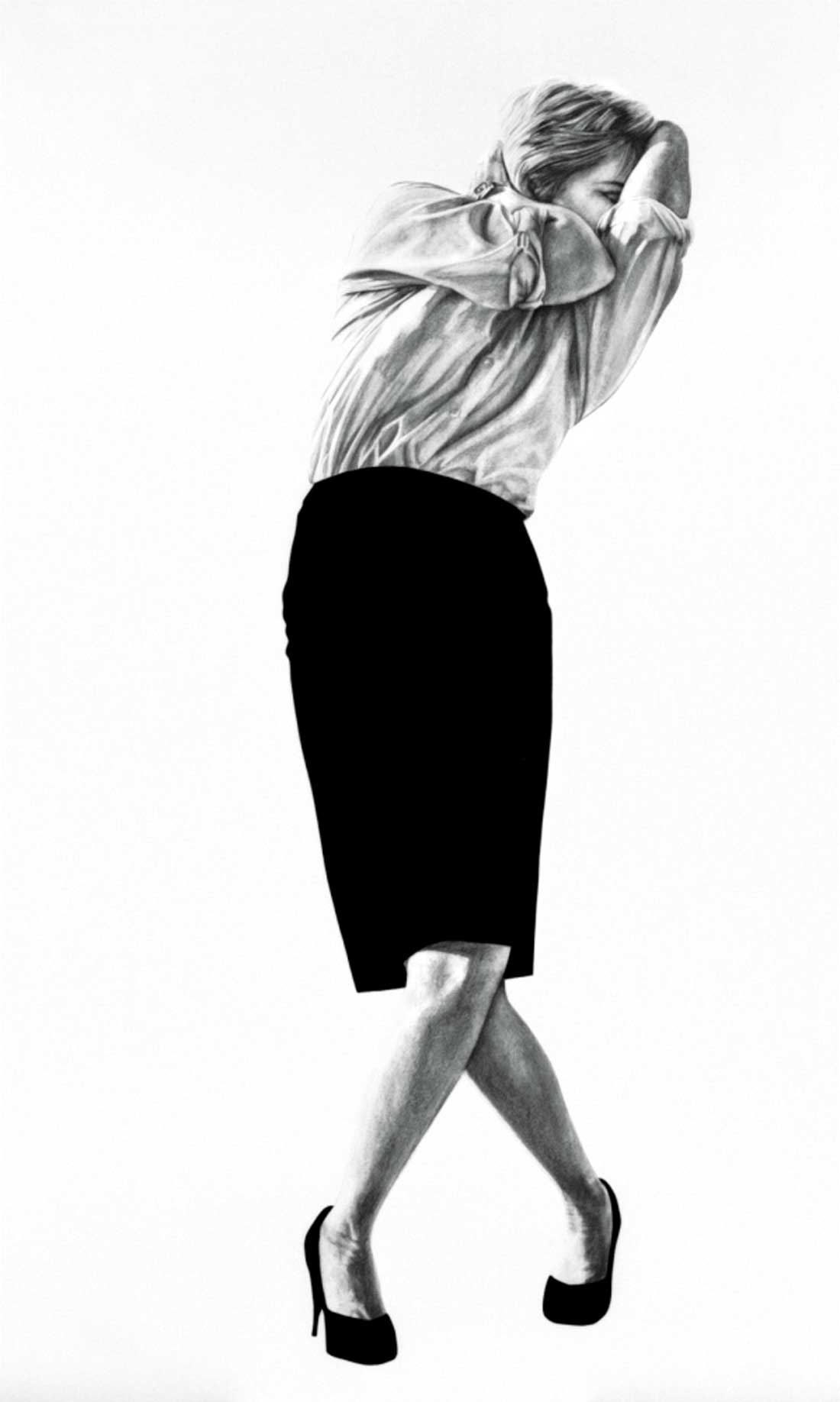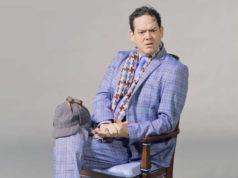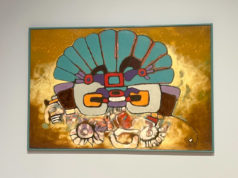It hits you like a rail of coke. The brightly neon-hued images and three-dimensional ephemera that cover every inch of the small dark room –– records, a piano, boom boxes, TVs, a Star of David, children’s toys, tinsel –– pulsate and jive like the super-loud pop music, from The O’Jays’ “Love Train” to some tropicália disco, blaring through hidden speakers. As the delirium eventually ebbs, or as the overall loudness begins to disorient you, another though less invigorating sensation arrives: How in the hell did they do this?
Multi-disciplinary artist Kenny Scharf’s totalizing environment, part of his Cosmic Cavern series dating back decades, is a, um, high point in Urban Theater: New York Art in the 1980s, a broad survey that will remain at the Modern Art Museum of Fort Worth until Jan. 4. Covering 25,000 square feet of gallery space (and a couple of feet in the gift shop, of course), the exhibit, organized by Modern curator Michael Auping and featuring just about every heavy hitter –– including Laurie Anderson, Jean-Michel Basquiat, Francesco Clemente, Nan Goldin, Keith Haring, Jenny Holzer, Jeff Koons, Barbara Kruger, Robert Longo, Robert Mapplethorpe, David Salle, Julian Schnabel, Cindy Sherman, and, of course, Andy Warhol, whose monumental self-portrait in green with part of his white hair elevated greets museumgoers –– raises another question: Why the hell are they doing this now?
In the accompanying catalog, Auping simply writes, “As the artists who emerged in that decade now set records at auction, the era is ripe to be re-examined,” ignoring –– willfully or not –– the context of the show. The Decade of Decadence appears to be coming back in more ways than one. Instead of the Cold War, the West’s meta-narrative is the threat of terrorism, which could also explain our devotion to escapist fantasies in entertainment, the return of giddy, Memphis Group-inspired design (lots of geometric shapes and bold, often-incongruent colors), and skinny jeans.
You’ve got to wonder when it all happened, when the door with “The ’80s are cool!” spray painted across it was shut, and the door that said, “The ’80s are sooo unhip” opened –– and then when that door shut, and the door with “The ’80s are OK to like again!” opened. Today, when anything (and everything) goes, thanks to the gradual but nearly complete shift in tastemaking power from the journalistic elite and a handful of corporations to the general public, fashion looks even more ridiculous. As Urban Theater proves, the ’80s were full of art that transcends era.
Some of the most traditionally powerful pieces are from Longo’s Men in the Cities series (1979-82). Slightly larger-than-life figures in business attire strike jarring poses in his buttery, precise charcoal drawings. Others include Basquiat’s views of primitivism through graffiti via jittery, skull-obsessed paintings and Schnabel’s massive “Zum Solitaire,” a creamy painterly abstraction on brown carpet in which a thick white arc (on which “Solitair” [sic] is painted in black) cradles a bulbous hieroglyph (on which “Zum” is written in yellow and purple).
Representing (gasp!) representational painting is Eric Fischl’s iconic “Bad Boy.” As an adolescent male reaches into a purse behind him, he stares at a woman lying naked on a bed with her legs spread. Great painting “Bad Boy” is not, technically, but with its confrontational sexuality and daytime-noir vibe (the sunlight shining through the slats in the blinds seems as lotus-like and deadly as heroin), the 1981 oil-on-canvas resonates like a framed movie.
As broadcast by the exhibit’s title, a lot of ’80s art was influenced by theater. Though previous generations of visual artists had tried, ’80s visual artists, according to Urban Theater, succeeded in taking art outside the frame. Where most of them placed it was on the stage, both figuratively and literally –– a lot of Anderson’s work was dance- and music-based. Even Longo’s patient drawings had a theatrical undergirding. He worked from photographs that he took of his doing-everything-but-sitting sitters. To get his people moving, he hurled objects at them or played music.
One famous and successful ’80s artist was concerned with only the moment in stylized movement. In photographing herself as filmic stereotypes (the femme fatale, the damsel in distress, the harpy), Cindy Sherman underlined their inherent banality and cheapness. Since her work was chic but not particularly novel –– her self-portraits might as well have been painted –– it probably makes some contemporary viewers uncomfortable. “Anyone could have done that,” they may mutter while stalking the galleries. And while true, no one had thought to do it at the time, pointing up conceptual art’s paradoxical essence. It is art that is of the moment, and when that moment passes, all that’s left is dusty history. The brain parts may be stimulated by that but not much else –– but sometimes the brain parts could use a little stimulation. Life can’t be all Cosmic Caverns.
The ’80s also were full of work that was groundbreaking at the time but that was so piercing and so true –– and so, well, expected –– that it became an essential part of the mainstream that we all know and may be terribly bored with today. Big photographs, text-based paintings, riffs on advertising –– they all really started here.
What’s sad is that Urban Theater throws into vast relief how far we have not come since the ’80s. The Guerrilla Girls, whose anonymous feminist work occupies an entire Modern gallery, and rightfully so, are still active. They were inspired (infuriated into action?) by the white-male-dominated art establishment. The Girls covered New York City with fliers like “How Many Women Had One-Person Exhibitions at NYC Museums Last Year?” (just one, at the Museum of Modern Art), “Only 4 Commercial Galleries in N.Y. Show Black Women, Only 1 Shows More than 1,” and “It’s Even Worse in Europe.” In addition to railing against the art world for ignoring or dissing women artists –– still –– the new Girls have spread their righteous wrath to the worlds of business and politics. As you can imagine, there’s lots of material there.
The Modern doesn’t deserve a medal or anything for Urban Theater. Auping and company are celebrating a decade that the cognoscenti deemed safe to appreciate years ago. But props to the museum for reminding us that the same 10 years that gave us Ronald Reagan, the Cold War, the AIDS epidemic, Chia Pets, and ballet flats with stirrup pants also produced hip-hop, A Brief History of Time, the Bill T. Jones/Arnie Zane Dance Company, Thriller, the destruction of the Berlin Wall, Big Trouble in Little China, and most of the artists in Urban Theater. Start a love train –– to the recent past –– indeed.
[box_info]
Ubran Theater: New York Art in the 1980s
Thru Jan 4 at the Modern art Museum of Fort worth
3200 Darnell St, FW. 817-738-9215.
[/box_info]












